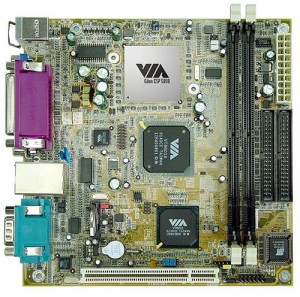A motherboard is a printed circuit board that contains the stuff that makes up the computer, or it has slots to put some of that stuff in. Your computer is a box of electricity, and what makes it work and display stuff to you is the flow of that electricity. Each component in the computer has a printed circuit board on it or in it, and the circuit board is, in the very simplest of terms, a system of gates that controls the flow of electricity. We’re talking millions of gates, and they open and close hundreds or thousands of times each second, determined by a command issued. Pressing a key on the keyboard or clicking the mouse on something is a command; it generates a set of instructions to open or close a particular series of gates to make something happen. Your keyboard and mouse connect to the motherboard through an interface–the part that you plug them into, the part of the connection to the computer that you can see. The motherboard has a special place for the processor, and the processor and the motherboard must be compatible. If you were building a computer, you would look for certain characteristics of one, and match it up with the other. That’s a subject for another day, and when I get that written, I’ll link to it from here. The motherboard has slots for your RAM, connections for your drives, video card, USB ports, and it also has expansion slots. Those are for other stuff you might want to add, like an upgraded video card (gamers and graphic designers need video on steroids), and at one time network connections were provided through the expansion slots. (Yes, there was a time when connectivity was not the default). The power from the wall connects to a power supply component, which has octopus arms that connect to the motherboard itself and to the components in the computer that need more power than they can get just from the board. Motherboards are also called system boards and planar boards. There is a lot more to know about motherboards, but this is a basic rundown of what everyone needs to know.
photo credit viagallery.com
